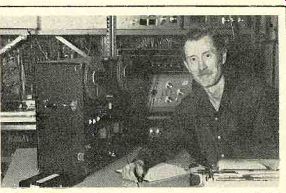
by CRAIG STARK
LOST IN THE GAP
LAST month, in discussing playback equalization curves, we saw that be ginning with a specified upper-middle "turnover" frequency (ranging from 1,326 Hz for ferric-oxide cassettes to 3,183 Hz for 7 1/2-ips open-reel) the inherently rising frequency response of the playback head was permitted to reassert itself. This is at the cost of increased amplification of tape hiss, but it is necessary to help offset some of the severe treble losses involved in the recording process.
Unfortunately, at the very highest audio frequencies playback heads often can't provide their "natural" 6-dB-per-octave treble boost-they don't keep doubling their output for each doubling of the frequency (given equal signal levels on the tape). To see why this is so we must explore the relationship between the play back-head gap and the "wavelength" of the signals it must pick up.
Simply defined, the recorded wave length (conventionally designated by the Greek letter X) of a signal is equal to the tape speed divided by its frequency.
Thus, at 15 ips a 15,000-Hz tone has a wavelength (X) of 0.001 inch-that is, one "mil" (a thousandth of an inch) or 1,000 microinches. At 7 1/2 ips the same one-mil X represents a frequency of 7,500 Hz; at 3 3/4 ips it is 3,750 Hz; and at 1 7/8 ips the one mil X is only 1,875 Hz.
The troubles begin, however, when one wants to keep the same maximum high frequency-20,000 Hz, for example and obtain it at successively slower speeds, for now the wavelengths involved become progressively shorter. At 7 1/2 ips, a 20,000-Hz X is a moderately easy 0.375 mil (375 microinches). More formidable but still achievable is the 20,000-Hz wavelength at 33/4 ips: 0.1875 mil. To get to 20,000 Hz with cassettes, however (and a tiny handful of super machines can do it), the playback head must resolve a wavelength of 0.09375 mil.
That's only 93.75 millionths of an inch for each full cycle of a sine-wave tone.
The fact that we're dealing with signal wavelengths in the vicinity of 100 microinches brings significant playback-head "gap losses" into the picture. The formula for calculating gap losses is rather complex, but why they arise can be intuitively understood by considering the following point. When a playback head's magnetic gap length (which is always somewhat longer than its physical measurement) is exactly equal to one wave length of the recorded signal, both poles of the head "see" exactly the same magnetic potential as the tape moves across them; that is to say, they "track" each point on the waveform in unison. The result is that there is never any magnetic differential between the two pole pieces, so no electrical signal is generated in the head at all, and an infinite "gap loss" takes place. From this it follows that the absolute maximum playback voltage the head can produce will occur when its magnetic gap length is one-half the re corded wavelength. (Even here the head's output has fallen below a pure 6-dB-per-octave rising response by 3.9 dB.) The head's magnetic gap, then, should always be a small fraction (never more than one half) of the wavelength it must reproduce from the tape.
Putting this into practical terms, only a few years ago a head with a gap length as short as 250 microinches was a rarity.
Today, the typical physical gap on a high-quality open-reel machine is likely to be about 100 microinches, and the approximate magnetic gap length would run about 120 microinches. At 7 1/2 ips, gap loss on a 15,000-Hz tone would amount to an insignificant 0.8 dB. At 3 3/4 ips, the loss would be up to 3.6 dB, which is easily made up in the playback equalization. At 1% ips, however, the 15,000-Hz loss from that head would be 27.6 dB! The solution lies in narrower gap heads for cassettes. Manufacturers have proved that they can be produced, but it is not easy.
Also see:
ELVIS PRESLEY--It just wouldn't have been the same without him, ASHELEY R. and KERRIN L. GRIFFITH
AUDIO BASICS--The New London Cassettes